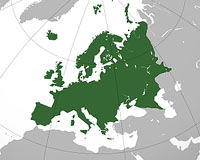| . |  |
. |
Athens OH (SPX) Apr 22, 2010 A new study led by Ohio University scientists suggests that early Native Americans left a bigger carbon footprint than previously thought, providing more evidence that humans impacted global climate long before the modern industrial era. Chemical analysis of a stalagmite found in the mountainous Buckeye Creek basin of West Virginia suggests that native people contributed a significant level of greenhouse gases to the atmosphere through land use practices. The early Native Americans burned trees to actively manage the forests to yield the nuts and fruit that were a large part of their diets. "They had achieved a pretty sophisticated level of living that I don't think people have fully appreciated," said Gregory Springer, an associate professor of geological sciences at Ohio University and lead author of the study, which was published a recent issue of the journal The Holocene. "They were very advanced, and they knew how to get the most out of the forests and landscapes they lived in. This was all across North America, not just a few locations." Initially, Springer and research collaborators from University of Texas at Arlington and University of Minnesota were studying historic drought cycles in North America using carbon isotopes in stalagmites. To their surprise, the carbon record contained evidence of a major change in the local ecosystem beginning at 100 B.C. This intrigued the team because an archeological excavation in a nearby cave had yielded evidence of a Native American community there 2,000 years ago. Springer recruited two Ohio University graduate students to examine stream sediments, and with the help of Harold Rowe of University of Texas at Arlington, the team found very high levels of charcoal beginning 2,000 years ago, as well as a carbon isotope history similar to the stalagmite. This evidence suggests that Native Americans significantly altered the local ecosystem by clearing and burning forests, probably to make fields and enhance the growth of nut trees, Springer said. This picture conflicts with the popular notion that early Native Americans had little impact on North American landscapes. They were better land stewards than the European colonialists who followed, he said, but they apparently cleared more land and burned more forest than previously thought. "Long before we were burning fossil fuels, we were already pumping greenhouse gasses into the atmosphere. It wasn't at the same level as today, but it sets the stage," Springer said. This long-ago land clearing would have impacted global climate, Springer added. Ongoing clearing and burning of the Amazon rainforest, for example, is one of the world's largest sources of greenhouse gas emissions. Prehistoric burning by Native Americans was less intense, but a non-trivial source of greenhouse gases to the atmosphere, he said.
Share This Article With Planet Earth
Related Links Ohio University All About Human Beings and How We Got To Be Here
 Europe Mulls Ways To End Air Traffic Chaos
Europe Mulls Ways To End Air Traffic ChaosMoscow, Russia (RIA Novosti) Apr 21, 2010 Airlines operating in Europe have suffered huge losses since Iceland's Eyjafjallajokull volcano began erupting Wednesday for the second time in a month, spewing a cloud of ash over Europe that has grounded flights and stranded passengers. On April 19, the EU transportation ministers will hold a video conference to draft an action plan. Airlines are testing whether flights are possible in t ... read more |
|
| The content herein, unless otherwise known to be public domain, are Copyright 1995-2010 - SpaceDaily. AFP and UPI Wire Stories are copyright Agence France-Presse and United Press International. ESA Portal Reports are copyright European Space Agency. All NASA sourced material is public domain. Additional copyrights may apply in whole or part to other bona fide parties. Advertising does not imply endorsement,agreement or approval of any opinions, statements or information provided by SpaceDaily on any Web page published or hosted by SpaceDaily. Privacy Statement |